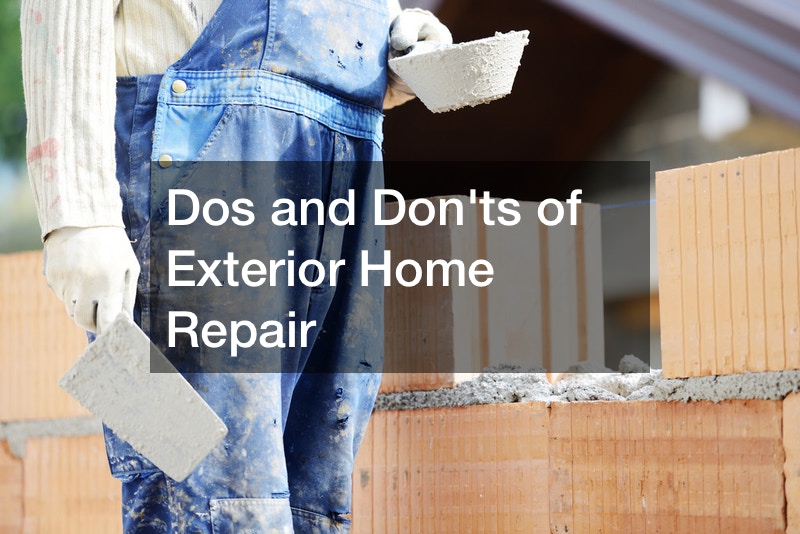

Numerous homeowners expend considerable effort and time renovating their houses to add that unique touch. While there is nothing wrong with adding improvements to a property’s look, the next buyer may not find them as appealing as you do. You may believe that when the time comes to sell, you will recoup every penny invested in your makeover, but a new buyer only sees the improvements necessary to make a property their own.
This article will discuss the most common dos and don’ts of DIY exterior home repair that homeowners should be aware of to ensure they get a good offer when it comes time to sell.
The Dos of DIY Exterior Home Improvements
Trim Your vegetation
Ensure that vegetation does not cause damage to the exterior of your home. You’ll want to hire tree cutting services near you to ensure that no tree branches are hanging over your house and causing damage to the shingles. Additionally, you should check your siding for any thick shrubs or other growth. Finally, maintain a minimum of a foot or two of clearance between plants and your home.
Repair concrete cracks
A DIY exterior home improvements list would be incomplete without repairing cracks. Concrete can fracture and deteriorate over time, necessitating periodic maintenance and repair. It would be best if you hired an asphalt paving service to repair your concrete immediately upon discovery, as they are easier to fix while they are small. Allow them to grow, and you’ll be faced with a larger repair task, one that may require professional assistance. Additionally, you’ll ensure the safety of sidewalks, which might become dangerous if cracks exist. Additionally, cracked concrete is unsightly, so it’s a good idea to get it repaired to improve the appearance of your property. To repair concrete cracks, thoroughly clean them and then patch them using compound or caulk, or use cement tile to patch up bad sectors.
Repaint Your exteriors

Maintaining an up-to-date paint job on the exterior of your home will help seal surfaces. This safeguards your home against moisture damage. You do not have to repaint every square inch; a simple touch-up may suffice. Bear in mind, however, that the shade may not fit perfectly. Keep a watch out for places that peel or lose paint frequently, as this may indicate a more significant moisture problem.
Repair and Do Roof Replacements
Another crucial component when it comes to DIY exterior home improvements is roof repairs and roof replacements. Your roof safeguards your property, but it may require upgrades to continue to do so. You can detect faults and imperfections in your roof by doing an exterior roof inspection using certified roofers. These flaws, which may allow moisture, rot, and even pests to enter your home, should be addressed promptly. For example, an assessment will search for damaged or missing shingles, rust patches, or cracked sealant on flashing, rotting, drooping, and flashing damage, among other things. Often, you may repair your roof rather than replace it entirely if it is still within its intended lifespan.
Inspect and Repair Your External Door
Cleaning and examining your external door shouldn’t be missing in this list of home improvements. At the very least once a year, clean the door with a mild cleaner. Avoid abrasive products that may damage your door, and refrain from scouring or power washing it. Either use baby shampoo, wood cleaner, or diluted dish soap to clean it. Remember to use as little water to avoid puddles. Wipe the glass panels clean using a glass cleaner.
While you’re cleaning it, remember to conduct a quick inspection. Inspect the door, waterproofing, and hardware components for damage. Watch out for cracks in the glass or frame, dampness, and fog between the panels, splits or symptoms of moisture, damage to the weatherstripping, or deterioration to the sweep. Additionally, watch for a chipped or peeled finish. If this is confirmed, you will need to repair your door.
Garage Door Replacement
While doing professional garage door repair is functional, it adds little to your property’s look or curbs appeal. If you’ve been having issues with your garage door repair recently, such as diagnosing a noisy garage door, it may be time to upgrade. Consider replacing them with more beautiful doors, such as carved doors, carriage-style doors, or contemporary-designed doors, to give this area of your home a new appeal.
Check your window frames.
When making home improvements, most homeowners disregard window frames. These frames last between 20 and 40 years on average, depending on the components used. However, other variables, such as pressure washing, weather factors, humidity, or improper installation, might shorten that period. When they are destroyed, your home will become drafty, resulting in a rise in your energy expenditures. Once a year, inspect them for any of the following symptoms that require repair:
- It feels drafty around the windows.
- It isn’t easy to open or close them.
- The panes or frames have cracks.
- Water leaks in when it rains.
- There is moisture between the glass.
- Gutter Repairs
When did you clean your gutters? This might be a surprise item on the DIY exterior home improvements list for most homeowners. If it has been a while, you should prioritize this task for your exterior property upkeep. While you’re cleaning, it’s a good idea to inspect your gutters for any other issues that could result in water damage.
Pay attention to the direction in which the water is flowing. Clogged gutters are a common source of improper water diversion. It can cause your drains to overflow, resulting in roof and foundation damage.
Repair Your Foundation

As with your roof, foundation care is critical to maintaining a comfortable and dry house. Often, you are unaware of an issue till it’s too late and a leak has arisen. Inspect your foundation twice a year, looking for cracks. Even small cracks, if left unattended for an extended time, can cause significant harm. You’ll want to call a masonry professional who can assist you in determining the best approach for keeping your foundation in good condition.
Fence Your Property
Any property could benefit from the addition of a fence. Fencing keeps children and pets safe, but it also adds significantly to your curb appeal. Fence installation may assist in defining your property while simultaneously providing elegance and appeal. Consider ornate wood fences with horizontal slats rather than vertical slats for a different aesthetic, or invest in new, low-maintenance vinyl fences that will keep your home looking wonderful for many years to come.
Repair Your Siding
Siding repair should never be missed on your home improvement list. Depending on the sort of siding you have, different types of care may be required. At the very least, you should inspect your siding for cracks and locations that may require repair. Annual power washing is recommended for vinyl siding, while wood siding should be treated approximately every four years to preserve it from the elements.
Concentrate On the Property’s ‘Bones’
When you decide to sell, and the buyer does an inspection, the major ticket items are the structural components (plumbing, roof, and so on), not the cosmetics. They’ll almost certainly want to choose their paintings and carpet, and the prospect of costly repairs may deter them. So prioritize structural upkeep above appearances.
Employ Neutral, Classic Styles
It would be best if you did repairs and upgrades according to the purpose for which the property is being developed. If you’re selling it, stick with neutral, traditional designs rather than fashionable ones. Typically, trends last between two and four years. Consider this time frame before making upgrades.
Maintain Records of All Improvements
We’re excellent at keeping track of every maintenance receipt for our automobiles, knowing that when selling or trading them in, those records are worth their weight in gold in terms of firming up the resale price and minimizing buyer haggling. Yet, when it comes to our houses, we fall short. When was the last time we replaced the washer and dryer? Which appliances are made of stainless steel? Five or more years ago? How old is the water heater? A seller can lose a lot of money due to inaccurate data.
Remodel To Complement the Neighborhood
When upgrading a property, it’s critical to consider the neighborhood’s aesthetic. While you may adore your 3,000-square-foot addition, it may be difficult to sell if your home is excessively built. Appliances, paint color, and landscaping all affect the resale value of a home. If you do choose to customize your home, keep in mind that you may need to revamp your remodel’ before listing it.
The Don’ts of Exterior Home Improvements
Don’t Make Repairs and Improvements You’ll Almost Certainly Need to Replace
Each home improvement project has associated expenses and advantages. While some fixes will persist, others will deteriorate and provide a danger of future damage. Therefore, do not choose a repair option solely based on timely availability, a low price, a persuasive salesman, or your gut feeling. Instead, analyze each purchase you make regarding the potential expense of maintenance or the frequency with which something will have to be replaced.
Make deliberate choices based on reliable information and understanding, as well as a comprehensive view of your exterior home remodeling and financial objectives. This attitude is critical at all times, but it can be difficult to maintain when doing repairs.
Don’t Make Hasty Decisions

When it comes to home improvements, we recommend our clients to set a realistic schedule. Unfortunately, most building owners move too hastily. It’s not possible to restore your structure to its original state or a better state in a short time. Unfortunately, realistic schedules can be as long as six months.
While it will take time for everything to return to normal or improve your exterior, this might be an excellent opportunity to rethink your building selections and establish a more solid strategy for the future.
Don’t Make Only Aesthetic Considerations
It is natural to want to look good. This desire extends to our homes, which is why homeowners are prepared to splurge thousands—or even hundreds of thousands—of dollars to repaint their entire home, install trendier, classier windows, upgrade to mahogany, or rosewood doors, install ornate siding and re-shingle their roof.
Unfortunately, one of the really costly—and possibly most common—exterior remodeling mistakes a homeowner may make is to overlook crucial repair areas in favor of aesthetics and taste. For instance, your home’s foundation may require more attention than its paint. Alternatively, while the ornamental siding may be attractive, does it protect your walls?
While there is nothing amiss with improving the appearance of a home, exterior remodeling should prioritize functional needs over aesthetic ones.
Don’t Take On Large Projects by Yourself
While making DIY exterior home improvements is fun, occasionally, a task is too hard to complete on your own. Unfortunately, no number of online tutorials will equip you with the necessary skills.
Contractors possess a wealth of experience. They are aware of what to anticipate during a project. Most essentially, contractors understand how to resolve serious issues before they wreak havoc on your budget.
Don’t Use the Wrong Tools
Avoid making home improvements without the correct equipment. Let’s face it; a swimming pool cannot be dug with a single shovel. The project would take forever to complete. Make sure to factor in equipment rental fees when budgeting for outside renovations. The correct tools will help you avoid costly errors or delays.
Avoid Attempting to Save Money by Using Low-Quality Materials
Giving your home’s exterior a complete makeover is likely to be an expensive endeavor. That said, consider the long-term rewards and avoid attempting to save today through low-risk investments. For example, the siding of a low grade may need to be replaced sooner, or the paint will need to be touched up more regularly. If you’re on a budget, speak with your contractor instead. They’ll have some DIY exterior home improvements suggestions and alternatives that will get you what you need without blowing your budget.
Avoid Starting Home Improvements Without a Plan
Once home improvement projects begin, it may be tempting to add to the scope of the project. The risk is that you will end up paying far more than anticipated or possibly deviating from your original plans. While the latter is not necessarily a bad thing, it is critical to plan. Once you’ve developed an idea, run it past your contractor for professional advice and ensure it fits your budget.
Avoid Starting Home Improvements Without a Budget

In terms of budgeting, begin with a complete and detailed DIY exterior home improvements budget. This way, you can easily monitor your expenses and know exactly what to expect in the end. Then, develop a separate budget to use as a contingency fund. This could be for luxury upgrades or features you wish to add. By allocating a contingency budget to yourself, you will know how much money you can spend without endangering going over. Additionally, it can assist in covering the cost of any unforeseen problems that arise.
Not Filing Building Permits
Each county has its own set of guidelines about whether DIY exterior home improvement projects require a construction permit. Contact the country during the planning stage to determine whether your project requires one. Avoid sneaking into a large renovation project. If the country learns of your whereabouts, they will locate you. Additionally, to the penalties, they may order you to demolish it.
Don’t Jump Into the Trend Train
Certain homeowners tend to incorporate any home improvement trend. They do it regardless of whether the DIY exterior home improvement’s theme fits their home or not. All they care about is appearing cool.’ So, while everything may appear to be in order, you may discover that it is not once the improvements are complete.
Home improvement trends are transient and might go away over time. This will compel you to discard it and begin searching for a new style. Not to mention the funds you will have squandered on both initiatives.
Don’t Do Excessive Renovations
We recognize that home renovations may be stressful, which is why you may believe it’s a good idea to complete them all at once. However, to accomplish too much at once may be a mistake. Therefore, when determining your budget for DIY exterior home improvements, you must also consider the amount of time required.
Are you employed? Are you a parent? These responsibilities are in addition to the time commitments imposed by a home restoration project. By focusing on one project simultaneously, you may better direct your attention and achieve the desired results.
Failure to Speak Up
If you are dissatisfied with the progress of your DIY exterior home improvements, it is up to you to speak out. Only you are aware of what you desire, and only you will be dissatisfied if you do not receive it. The sooner you raise your concerns with an expert, the easier it will resolve the issue. Homeowners who remain silent will feel unsatisfied, rendering their most recent makeover a waste of money. Additionally, any reputable renovation contractor will be able to collaborate with you to achieve your desired outcome.
It shouldn’t take more than a week to assess and clean up the exterior of your property. However, if you discover that any repairs are necessary, it is preferable to do it immediately rather than later. Please select a day every six months to evaluate the exterior of your property and avoid problems before they begin. Also, remember to contact the services of a personal injury lawyer whenever you get injured when making these DIY exterior home improvements. This list of dos and don’ts will improve your home’s look and increase its value when you decide to sell your property.



